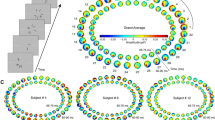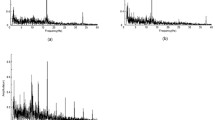Summary
The purpose of the present study was to map sensory-evoked potentials to foveally presented square-wave gratings of different spatial frequencies with a high density electrode montage. Scalp isocontour voltage and scalp current density (SCD) maps were computed to assess differences in scalp topography of the sensory-evoked responses as a function of spatial frequency. Topographic analysis showed a segregation of evoked responses to stimuli of different spatial frequencies. While low frequency patterns elicited a bilateral positive potential localized at lateral occipital sites from 60–120 msec, high frequency patterns elicited a prominent midline occipital negative potential. SCD revealed that, for any spatial frequency, two current density foci were evident: an earlier negative focus (current sink), centered at mesial-occipital areas, and a later positive focus (current source), centered at lateral-occipital regions of the scalp. The current source was much more prominent than the sink for lower spatial frequency, and vice versa. Moreover, the source was larger over the right side of the scalp, whereas the current sink shifted from the right to the left side as spatial frequency increased. The present electrophysiological findings suggest the view that: (1) visual sensory-evoked potentials elicited by low versus high spatial frequencies have different polarity and topographic localization, (2) these potentials might reflect the activation of functionally distinct, topographically segregated, neural generators differentially activated as a function of spatial frequency, and (3) these generators seem asymmetrically distributed over the left (LH) and right (RH) hemispheres.
Similar content being viewed by others
References
Aine, C.J., Bodis-Wollner, I. and George, J.S. Spatial frequency segregation and evidence for multiple sources. In: S. Sato (Ed.), Advances in Neurology, Vol. 54, Magnetoencephalography. Raven Press, New York, 1990: 141–155.
Bodis-Wollner, I., Brannan, J.R., Nicoll, J., Frkovic, S. and Mylin, L. A short latency cortical component of the foveal VEP is revealed by hemifield stimulation. Electroenceph. Clin. Neurophysiol., 1992, 84: 201–208.
Blumhardt, L.D., Barret, G, Halliday, A.M. and Kriss, A. The effect of field size on the pattern reversal visual evoked response. Clin. Vis. Science, 1989, 4: 27–40.
Brandeis, D., Naylor, H., Halliday, R., Callaway, E. and Yano, L. Scopolamine effects on visual information processing, attention and event-related potential map latencies. Psychophysiology, 1992, 29: 315–336.
Celesia, G.C. Visual evoked responses. In: J.H. Owen and H. Davis (Eds.), Evoked potentials testing: Clinical application. Grune and Stratton, Orlando, 1985: 1–54.
Desimone, R. and Schein, S. J. Visual properties of neurons in area V4 of the macaque: Sensitivity to stimulus form. J. Neurophysiol., 1987, 57: 835–868.
Drasdo, N. Cortical potentials evoked by pattern presentation in the foveal region. In: C. Barber (Ed.), Evoked Potentials. MTP Press Limited, Falcon House Lancaster, England, 1980: 167–174.
Harter, M.R., and White, C.T. Evoked cortical responses to checkerboard patterns: effect of check size as a function of visual acuity. Electroenceph. Clin. Neurophysiol., 1970, 28: 48–54.
Hellige, J.B. Hemispheric asymmetries. What's right and what's left. Harvard University Press, Cambridge, 1993.
Hudnell, H.K., Boyes, W.K. and Otto, D.A. Stationary pattern adaptation and the early components in human visual evoked potentials. Electroenceph. Clin. Neurophysiol., 1990, 77: 190–198.
Jones, R., and Keck, M.J. Visual evoked response as a function of grating spatial frequency. Invest. Ophtalmol. Vis. Sci., 1978, 17:652–659.
Kenemans, J.L., Kok, A. and Smulders, F.T.Y. Event-related potentials to conjunctions of spatial frequency and orientation as a function of stimulus parameters and response requirements. Electroenceph. Clin. Neurophysiol., 1993, 88: 51–63.
Kulikowski, J.J., Murray, I.J. and Perry, N.R.A. Electrophysiological correlates of chromatic-opponent and achromatic stimulation in man. Col. Vis. Def., 1989, 9: 145–153.
Kuroiwa, Y., Celesia, G.G. and Tohgi, H. Amplitude difference between pattern-evoked potentials after left and right hemifield stimulation in normal subjects. Neurology, 1987, 37: 795–799.
Lennie, P. Parallel visual pathways: A review. Vis. Res., 1980, 20: 561–594.
Lesèvre, N. Chronotopographical analysis of the human evoked potential in relation to visual field data from normal individuals and hemianopic patients. In: I. Bodis-Wollner (Ed.), Evoked Potentials. Ann. NY Acad. Sci., 1982, 388: 635–641.
Lesèvre, N. and Rèmond, A. Potentiels evoques par l'apparition de patterns: Effets de la dimension du pattern et la densite des contrastes. Electroenceph. Clin. Neurophysiol., 1972, 32: 593–604.
Livingstone, M.S. and Hubel, D.H. Segregation of color, form, movement and depth: Anatomy, physiology and perception. Science, 1988, 240: 740–749.
Mauguière, F., Giard, M. H., Ibañez, V. and Pernier, J. Cartes spatiales sequentielles des potentiels visuels evoques par inversion de damiers: influence du champ retinien stimule sur la topographie des responses. Rev. Electroenceph. Neurophysiol., 1985, 15: 129–137.
Merigan, W.H. and Maunsell, J.H.R. How parallel are the primate visual pathways? Annu. Rev. Neurosci., 1993, 16: 396–402.
Mitzdorf, U. The physiological causes of VEP: Current source density analysis of electrically and visually evoked potentials. In: R. Q. Cracco and I. Bodis-Wollner (Eds.), Evoked Potentials. New York: Alan R. Liss, Inc., 1986: 141–154.
Ossenblock, P., De Munck, J.C., Wierings, H.J., Reits, D. and Spekreijse, H. Hemispheric asymmetry in the maturation of the extrastriate checkerboard onset evoked potential. Vision Res., 1994, 34: 581–590.
Ossenblock, P. and Spekreijse, H. The extrastriate generators of the EP to checkerboard onset. A source localization approach. Electroenceph. Clin. Neurophysiol., 1991, 80: 181–193.
Parker, D.M., Salzen, E.A. and Lishman, J.R. Visual-evoked responses elicited by the onset and offset of sinusoidal gratings: latency, waveforms, and topographic characteristics. Invest. Ophtalmol. Vis. Sci., 1982, 22: 675–680.
Paulus, W.M., and Plendl, H. Spatial dissociation of early and late colour evoked components. Electroenceph. Clin. Neurophysiol., 1988, 71: 81–88.
Perrin, F., Pernier, J., Bertrand, O. and Echallier, F.J. Spherical splines for scalp potentials and current density mapping. Electroenceph. Clin. Neurophysiol., 1989, 72: 184–187.
Plant, G.T., Zimer, R.L. and Durden, K. Transient visually evoked potentials to the pattern reversal and onset of sinusoidal gratings. Electroenceph. Clin. Neurophysiol., 1983, 56: 147–158.
Previc, F. H. The neurophysiological significance of the N1 and P1 components of the visual evoked potential. Clin. Vis. Sci., 1988, 3: 195–202.
Proverbio, A.M., Zani, A. and Mangun, G.R. Electrophysiological substrates of visual selective attention to spatial frequency. Bull. Psychonom. Soc., 1993, 31: 368.
Proverbio, A.M., Zani, A., Gazzaniga, M.S. and Mangun, G.R. Hemispheric asymmetries to spatial frequency as revealed by visual-evoked potentials in a split-brain patient. Abstract Book of the “Cognitive neuroscience Society: Second Annual Meeting”, Cognitive Neuroscience Society, San Francisco, 1995: 77.
Proverbio, A.M., Zani, A., and Avella, C. Asymmetric generators for visual sensory potentials to hemifoveal stimuli. Abstract Book of the “Cognitive neuroscience Society: Third Annual Meeting”. Cognitive Neuroscience Society, San Francisco, 1996: 94.
Reed, J.L., Marx, M.S. and May, J.G. Spatial frequency tuning in the visual evoked potential elicited by sine-wave gratings. Vision Research, 1984, 24: 1057–1062.
Regan, D. Human Brain Electrophysiology. Evoked potentials and evoked magnetic fields in science and medicine. Elsevier, Amsterdam, 1989.
Sergent, J. The cerebral balance of power. Confrontation or cooperation? J. Exp. Psychol. (Hum. Percept. Perf.), 1982, 8: 253–272.
Sergent, J. and Hellige, J. Role of input factors in visual field asymmetries. Brain and Cogn., 1986, 5: 174–199.
Schroeder, C.E., Tenke, C.E., Givre, S.J., Arezzo, J.C. and Vaughan, H.G., Jr. Striate cortical contribution to the surface-recorded pattern-reversal VEP in the alert monkey. Vision Res., 1991, 31: 1143–1157.
Skrandies, W. Scalp potential fields evoked by grating stimuli: effects of spatial frequency and orientation. Electroenceph. Clin. Neurophysiol., 1984, 58: 325–332.
Skrandies, W., Richter, M. and Lehmann, D. Checkerboard-evoked potentials: Topography and latency for onset, offset, and reversal. Prog. Brain Res., 1980, 54: 291–295.
Tootell, R. B., Silverman, M. S., De Valois, R. L. Spatial frequency columns in primary visual cortex. Science, 1981, 214: 813–815.
Van Dijk, B.W. and Spekreijse, H. Localization of the visually evoked response: the pattern appearance response. In: K. Maurer (Ed.), Topographic Brain Mapping of EEG and Evoked Potentials, Springer, Berlin, 1989: 360–365.
Zani, A. and Proverbio, A.M. Attention modulation of early components of ERPs to lateralized gratings in the upper and lower visual quadrants. Abstracts Book of “The Fifth International Evoked Potentials Symposium”. Ospedale San Raffaele, Milano, 1994: 269.
Zani, A. and Proverbio, A.M. ERP signs of early attention effects to check sizes. Electroenceph. Clin. Neurophysiol., 1995a, 95: 277–292.
Zani, A. and Proverbio, A.M. ERP signs of suppression of stimulus sensory processing at unattended locations in visual spatial attention. Abstract Book of the “Cognitive neuroscience Society: Second Annual Meeting”. Cognitive Neuroscience Society, San Francisco, 1995b: 44.
Zani, A. and Proverbio, A.M. Attention modulation of early latency ERPs by selective attention to conjunction of spatial frequency and location. J. Psychophysiol. (in press).
Author information
Authors and Affiliations
Corresponding authors
Additional information
This work was part of the Post-Doctoral Research Program carried out by A.M.P. at the Center for Neuroscience of University of California at Davis, where A.Z. was on leave from his Institute. The authors are deeply indebted to Dr. George R. Mangun for allowing the use of his Lab facilities and for helpful criticims. They would like also to thank Dr. Jonathan Hansen and Dr. Steven Hillyard for their kind support.
Rights and permissions
About this article
Cite this article
Proverbio, A.M., Zani, A. & Avella, C. Differential activation of multiple current sources of foveal VEPs as a function of spatial frequency. Brain Topogr 9, 59–68 (1996). https://doi.org/10.1007/BF01191643
Issue Date:
DOI: https://doi.org/10.1007/BF01191643




